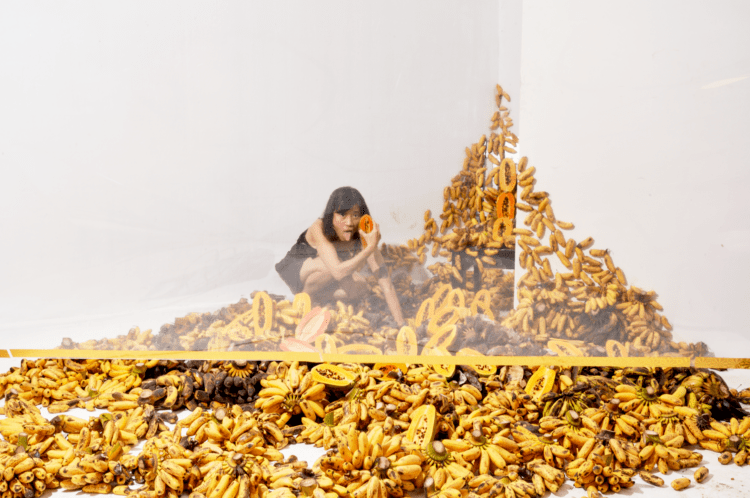
Last December, at the David Mooney Foundation in Chicago, nine contemporary Vietnamese artists came together to show their work. The exhibition included paintings, video, audio, sculptural installations and performance, presenting questions about cultural production, heritage, identity, memory, and dreams. The exhibition text states that the work moves “beyond the pervasive war and post-war narratives.”Thuy-Tien Vo (MA VCS 2024) at the School of the Art Institute of Chicago was one of the show’s curators and performers.
“A Village Before Us” was shown concurrently with the Albert Goodman Collection of Vietnamese post-war art, at the international Currents Gallery at the foundation.
“This chance was rare, and we were thinking about how we can make it work being a unique opportunity. So, we exhibited concurrently, and in response to the modern collections from the foundations. We can do our own exhibition, it doesn’t have to speak to the upstairs (Goodman) collection, but we chose to do it,” said Vo. By hosting artist talks and round table discussions, the exhibition also challenged the temporal and spatial confines of a gallery space.
In talking about her work, Vo often mentions the concept of “endlessness”; however, she finds it essential to clarify nuances, considering potential misinterpretations. Endlessness, as Vo perceives it, embodies the realm of possibilities within certain practices or understandings, often inaccessible to certain communities.
In the context of “A village before us,” too, for Vo, the post-exhibition engagement continues. “How do we keep the exhibition living on? The publications (pamphlets, exhibition texts) somehow last longer than the event itself,” she said.
In a statement published in 2018 by The Factory, a contemporary art center in Ho Chi Minh city, Vietnam, Vo is referred to as “tắc kè hoa sáng tạo”; a creative chameleon. This accolade accurately captures her versatile approach, which spans across mediums like storytelling, books, illustration, film, performance, photography, with photography being a recurring element.
In Vo’s practice and her choices of documenting and not documenting work, Vo poses important questions about institutionalization of art. Vo’s work has consistently defied institutional interpretations, which she often hints at through her choices of medium and language.
In “My Marriage,” one of Vo’s very first solo shows, she used a language that was part-private and part-public. “So we were in some specific circumstance of our marriage, and I really wanted to have that work to speak to my husband. So I used a language not everybody could understand,” she said.
Another significant exhibition, also shown in Vietnam, was “Flaw (Fall in Love Another Way),” which is a continuation after “My Marriage.”
“So work like this is not for the outsider audience. I mean, I didn’t expect them to understand or not understand or to misunderstand it,” Vo said.
Vo rarely makes work that has a sellable value. “I mean I respect and admire other people’s product-oriented work, but not for my personal practice and I do work that can flee and disappear and not be institutionalized and that is one of my executions of anti capitalism,” she said.
Vo’s work transcends conventional audience expectations, while also prompting a viewer to the essence of emotional turmoil inherent in the human experience.
“If my work is in a gallery, I consider a lot about what I want on the specific occasion that I am putting my work in a gallery on show,” Vo said. Her work is informed from a very specific reason, and that is what defines her medium more than the concern of interpretation does. “The act of sharing is to put my vulnerability on display. And it took a lot of courage to do that,” she said, talking about “FLAW.” “But nobody cares,” she continued. “I mean, when the work is out, it is out. It is also the reason I feel a little sorrow because everything can be commercialized.”
After relocating to Chicago, Vo has become especially aware of her dislocated identity. But here, too, she has been able to find a familiarity, with collaboration becoming a major element in her work. While collaboration can often streamline the realization of expected outcomes, in Vo’s journey, it unfolds differently.
Initially fixated on individual growth, because that’s where she believes the expectation is highest, her perspective shifted upon relocating to the US.
“I see the concept of individualism very differently than it was in my head,” Vo said. “Individualism here, is the manifestation of, or a product of, capitalism. And so to be in a collaboration is more challenging, and I want to put myself in that challenge.”
To Vo, collaboration signifies more than working in a team. It means genuine immersion in communal living, necessitating empathy and adaptability. Talking about her performance “[rehearsal]” in “A Village Before Us,” she talked about her expectations with collaboration.
“We didn’t talk a lot about the outcome, and even though we clearly know our expertise and know what we cast for [in the performance], but then what does it mean to be a performer, in this small society, this five people society?,” she said.
Vo said she deliberates on her intention of being together and living together.
“If I say it’s not about work, that would not be true, but it’s like how to put our individual practice together and that is the most important part of it. In the end we all became friends, these people became my best friends in Chicago,” she said.







